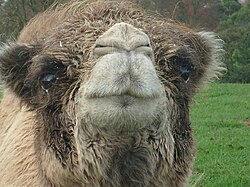Camel department
| Camel department | |||||||||||||||||||||
|---|---|---|---|---|---|---|---|---|---|---|---|---|---|---|---|---|---|---|---|---|---|
 Bactrian camel | |||||||||||||||||||||
| Classification | |||||||||||||||||||||
|
A creature classification unit artiodactyl as for the camel department (-) mammals (cow eyes). A camel or a llama used as a domestic animal in all parts of the world are included.
The mammalian red blood cell is no nucleus, and, as for the red blood cell of birds and reptiles, there is a nucleus in a circle, and normal, but only the animal of the camel department is no nucleus, but it has the red blood cell which did an oval in mammals to be an oval. In addition, unlike other mammals, is known to have a small antibody (nanoantibody) of the size to be comprised only of a heavy chain [1]; [2].
Table of contents
Evolution of the creature of the camel department
The current distribution of the creature of the camel department is totally different from the past distribution. An opinion that it was originally from North America was strong, and the friends of the camel might inhabit the Arctic Circle at one time again [3].
The creature of the camel department appeared in the current North American Continent in very early days of the artiodactyl evolution in last part of Eocene epoch approximately 45 million years ago. プロティロプス of the size like the rabbit was to the creature of the closely related oldest camel suborder in camel department and had four fingers to limbs. A side finger was lost by the Oligocene, and ポエブロテリウム of the size like the goat appeared [4]; [5].
The creature of the camel department continued differentiating afterwards in the North American Continent. A creature of the camel department appeared in Asia for the first time in before 20,000-3,000,000 years and moved to the North American Continent with the formation of the Panamanian isthmus. The friend of the camel of the North American Continent disappeared with what the first Homo sapiens emigrated to at the time when the glacial epoch terminated. It is thought that I was not able to adapt myself to an environmental change when the reason of the extinction was hunted exhaustively either. A creature of the camel genus continued differentiating in Eurasia, and closely related four kinds, llama, alpaca, guanaco, vicuna survived each other in South America.
The creature of the fossil class had the form that was much various than a creature of the camel department which existed. There was just 3.5m, too, and, in North American ティタノティロプス, the body to a shoulder was much than a current camel of approximately 2m bigger at the best. The Steno mils had a hoof in delicate creatures like a gazelle. アエピカメルス and オキシダクティルス were tall creatures such as the suitable giraffe to eat a leaf [4].
An interspecific hybrid by the natural mating called "ブフト" is made between an Arabian camel and the Bactrian camels. Artificial insemination enables a mongrel between the genus among an Arabian camel (male) and the lamas (female) and is called head (head).
Classification of the camel suborder
"†" shows an extinct system.
- Camel suborder
- †Agriochoeridae†
- †オレオドント department Merycoidodontidae†
- †カイノテリウム department Cainotheriidae†
- †クシフォドン department Xiphodontidae
- †Proto mole crickets department Protoceratidae
- †オロメリクス department Oromerycidae
- †プロティロプス genus Protylopus
- Camel department Camelidae
- †ポエブロドン subfamily Poebrodontinae
- †ポエブロテリウム subfamily Poebrotheriinae
- †ポエブロテリウム genus Poebrotherium
- †Mio rabbis subfamily Miolabinae
- †Steno mils subfamily Stenomylidae
- †Steno mils genus Stenomylus
- †フロリダトラグルス subfamily Floridatragulinae
- Camel subfamily Camelinae
- †カメロプス genus Camelops
- †プロカメルス genus Procamelus
- †アエピカメルス genus Aepycamelus
- †ティタノティロプス genus Titanotylopus
- †オキシダクティルス genus Oxydactylus
- Camel genus Camelus
- Arabian camel Camelus dromedarius
- Body high 160-210cm, 450-800 kg in weight. I inhabit the southwestern part of Asian Continent, the Australian (act of man distribution) dry zone from the northern part of Africa. There is the thing which a domestic animal and a domesticated thing made a half wild animal.
- Bactrian camel Camelus ferus (wild animal class), Camelus bactrianus (domestic animal class)
- Body high 190-230cm, 450-650 kg in weight. I inhabit the dry zone in Asia.
- †カメルス giga Camelus gigas
- †カメルス ヘステルヌス Camelus hesternus
- †カメルス Shiva Ren cis Camelus sivalensis
- Arabian camel Camelus dromedarius
- Vicuna genus Vicugna
- Llama genus Lama
Genealogical tree of the existing camel department
| Ancestor of the camel department | North America Before 12,000,000-25,000,000 years | Llamas | 10,400,000 years ago | 6,400,000 years ago | 1,400,000 years ago | Llama | South America |
| Guanaco | |||||||
| Vicuna | |||||||
| Alpaca | |||||||
| Camels | 8 million years ago | Bactrian camel | Asia | ||||
| Arabian camel | Asia, Africa | ||||||
Gallery
-
Cranial bones fossil of カイノテリウム
Footnote
- ^ Hamers-Casterman, C. et al., "Naturally occurring antibodies devoid of light chains", Nature 363, 446-448 (1993) doi: 10.1038/363446a0
- ^ W.W. Gibbs, "nanoantibody medicine that development advances," it is Nikkei science January, 2006 issue
- ^ "The Arctic Circle camel fossil discovery, Canada 3,500,000 years" ago. AFPBB News. (March 5, 2013)5 March 5, 2013 reading.
- ^ a b Savage, RJG, & Long, MR (1986). Mammal Evolution: an illustrated guide. New York: Facts on File. pp. 216-221. ISBN 0-8160-1194-X.
- ^ Palmer, D., ed (1999). The Marshall Illustrated Encyclopedia of Dinosaurs and Prehistoric Animals. London: Marshall Editions. pp. 274-277. ISBN 1-84028-152-9.
Outside link
This article is taken from the Japanese Wikipedia Camel department
This article is distributed by cc-by-sa or GFDL license in accordance with the provisions of Wikipedia.
In addition, Tranpedia is simply not responsible for any show is only by translating the writings of foreign licenses that are compatible with CC-BY-SA license information.
0 개의 댓글:
댓글 쓰기